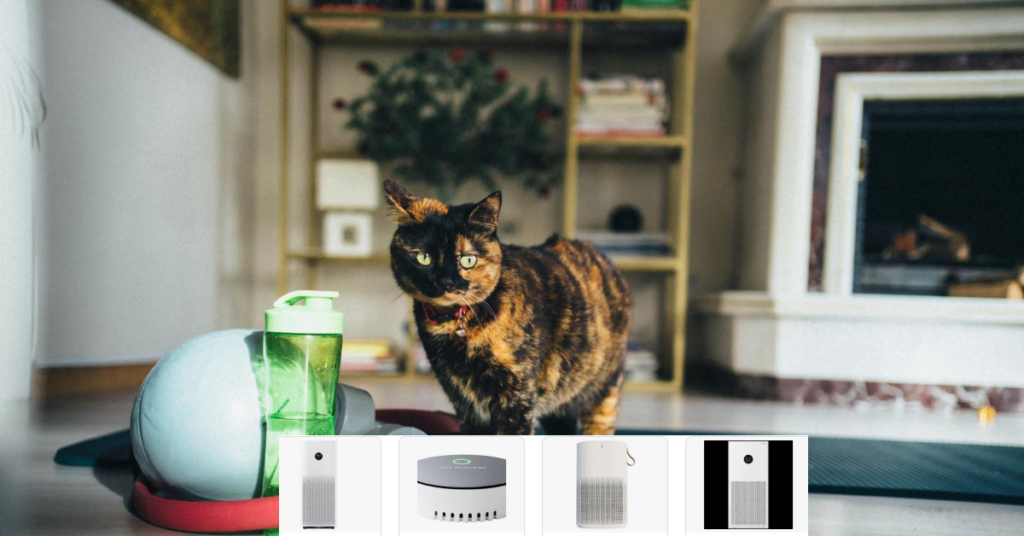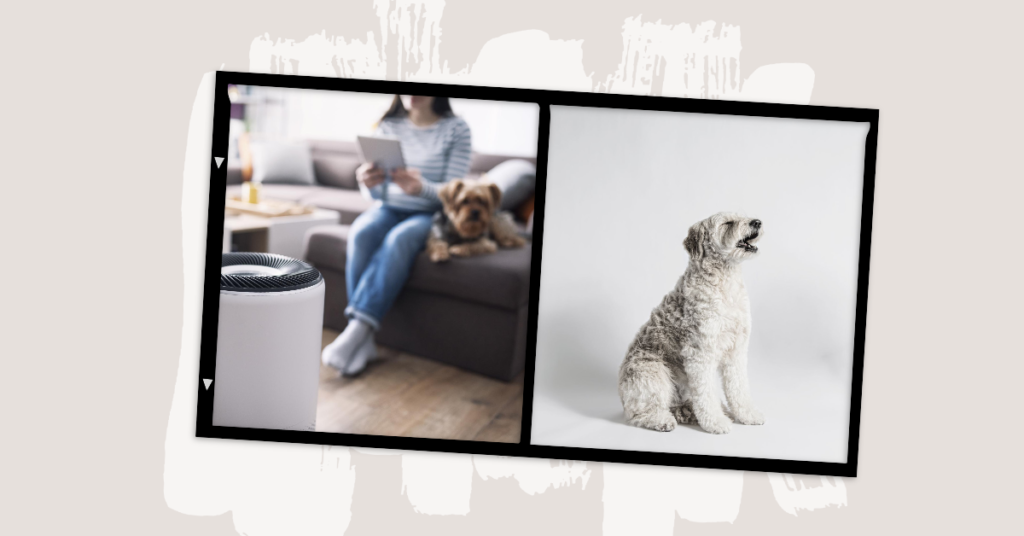When it comes to ensuring a clean and healthy environment for your pets, a pet air purifier can be an invaluable tool. This comprehensive guide will walk you through everything you need to know about pet air purifiers, from their benefits and features to tips for choosing the right one for your home. Whether you’re new to the concept or looking to upgrade your current device, this guide will provide you with all the information you need to make an informed decision.
According to the Asthma and Allergy Foundation of America (AAFA), allergies to pets are quite common, affecting between 10% and 20% of people worldwide. These allergies extend beyond just dogs and cats to include birds, hamsters, guinea pigs, rabbits, and more. As Melanie Carver, Chief Mission Officer of the AAFA, notes, “Air purifiers can help reduce your overall exposure to allergens, including pet dander.” When shopping for the best air purifier for pets, it’s essential to consider factors such as room size, ratings, and the type of filter used.
The type of filter is crucial, according to Allen Rathey, Director of the Indoor Health Council. He advises choosing an air purifier with a HEPA filter that includes a prefilter, which he refers to as “boulder catchers.” Rathey emphasizes that “merely having a HEPA filter is not the same as achieving HEPA-level filtration.” The effectiveness of HEPA filters depends on the volume and speed of air passing through them, which is essential for removing particles effectively.
Imagine a home where both you and your pets can breathe comfortably without worrying about allergens and pollutants. A pet air purifier can transform your living space by removing pet dander and odors, ensuring cleaner air. This guide will help you understand how these purifiers work, their benefits, and how to choose the best one for your home, making it easier to breathe easy and enjoy your time with your pets.
What is a Pet Air Purifier?
A pet air purifier is a specialized device designed to improve indoor air quality by removing pet-related pollutants such as dander, hair, and odors. Unlike standard air purifiers, pet air purifiers often come with features tailored to address the specific needs of pet owners.
How Does a Pet Air Purifier Work?
Pet air purifiers use a combination of filters and fans to capture and eliminate airborne particles. Typically, these devices include:
- Pre-filters: To catch larger particles like pet hair.
- HEPA filters: To trap smaller particles like dander and dust.
- Activated carbon filters: To neutralize odors.
The purified air is then circulated back into the room, creating a cleaner and healthier environment for both you and your pets.

Benefits of Using a Pet Air Purifier
Reduces Allergens
One of the primary benefits of a pet air purifier is its ability to reduce allergens in the air. Pet dander, which consists of tiny skin flakes, can trigger allergic reactions in sensitive individuals. A high-quality air purifier with a HEPA filter can significantly reduce the amount of dander in your home, providing relief for allergy sufferers.
Eliminates Pet Odors
Pets, especially those that are not house-trained, can leave unpleasant odors that linger in the air. An air purifier equipped with an activated carbon filter can effectively neutralize these odors, making your home smell fresher and more inviting.
Improves Overall Air Quality
In addition to targeting pet-related pollutants, a pet air purifier can improve overall indoor air quality. By removing dust, pollen, and other airborne contaminants, these devices contribute to a healthier living environment.

Key Features to Look for in a Pet Air Purifier
Filter Types
When choosing a pet air purifier, it’s essential to consider the types of filters it uses:
- HEPA Filters: Highly effective at capturing small particles, including pet dander.
- Activated Carbon Filters: Ideal for removing odors.
- Pre-Filters: Useful for trapping larger particles like pet hair.
Room Size Compatibility
Different air purifiers are designed for various room sizes. Ensure that the air purifier you choose is suitable for the room where it will be used. Check the manufacturer’s specifications for the recommended room size.
Noise Levels
Consider the noise level of the air purifier, especially if it will be placed in a bedroom or other quiet space. Look for models that operate quietly while still providing effective purification.
Ease of Maintenance
Regular maintenance is crucial for the optimal performance of your air purifier. Choose a model with easily accessible filters and straightforward maintenance procedures.
Top Pet Air Purifiers on the Market
Levoit Pet Air Purifier
The Levoit pet air purifier is renowned for its efficiency and user-friendly design. It features a HEPA filter and an activated carbon filter, making it a great choice for eliminating pet dander and odors. Additionally, it comes with a smart filter replacement indicator to help you keep track of maintenance.
Winix Pet Air Purifier
The Winix pet air purifier offers advanced filtration technology, including a HEPA filter, activated carbon filter, and a plasma wave technology that neutralizes pollutants at a molecular level. It’s designed for larger rooms and provides comprehensive air cleaning.
Shark Pet Air Purifier
The Shark pet air purifier is known for its powerful suction and effective filtration. With a HEPA filter and a pre-filter designed specifically for pet hair, this model is ideal for homes with multiple pets.
Hamilton Beach TrueAir Pet Air Purifier
The Hamilton Beach TrueAir pet air purifier is a compact and affordable option for those looking to improve air quality without breaking the bank. It features a permanent HEPA filter that captures pet dander and odors, making it a practical choice for small to medium-sized rooms.
How to Choose the Right Pet Air Purifier
Assess Your Needs
Consider the specific needs of your home and pets. For example, if you have multiple pets or suffer from severe allergies, you may need a more advanced model with higher filtration capabilities.
Compare Features and Specifications
Compare different models based on their features, including filter types, room size compatibility, and noise levels. Look for reviews and ratings to gauge the performance of each model.
Budget Considerations
While it’s important to invest in a quality air purifier, there are options available at various price points. Determine your budget and look for models that offer the best value for your money.
How to Maintain Your Pet Air Purifier
Regular Filter Replacement
To ensure the continued effectiveness of your air purifier, replace filters according to the manufacturer’s recommendations. Some models come with indicator lights to alert you when it’s time to change the filters.
Cleaning the Unit
Keep the exterior of the air purifier clean by wiping it down regularly. For models with removable parts, follow the manufacturer’s instructions for cleaning to prevent dust buildup.
Optimal Placement
Place the air purifier in a central location in the room, away from walls and furniture, to allow for maximum airflow. Avoid placing it near windows or doors where outdoor air could affect its performance.
Common Myths About Pet Air Purifiers
Myth 1: They Are Only for Allergies
While air purifiers for pet are highly effective for reducing allergens, they also help with odor control and overall air quality. They are beneficial for all pet owners, not just those with allergies.
Myth 2: They Are Too Noisy
Many modern air purifiers operate quietly, even on higher settings. Noise levels vary by model, so it’s essential to choose one that fits your needs and preferences.
Myth 3: They Are Expensive to Maintain
While there are costs associated with filter replacements, many air purifiers for pet are designed for easy maintenance and offer long-term benefits that outweigh the costs.
Conclusion
Choosing the right pet air purifier can make a significant difference in the quality of your indoor air and the comfort of your pets. By considering your needs, comparing features, and maintaining the unit properly, you can ensure a healthier and more pleasant living environment.
Whether you opt for a Levoit pet air purifier, a Winix pet air purifier, or another top-rated model, investing in a high-quality air purifier is a step toward better air quality and a happier home for you and your furry friends.
FAQ
Do air purifiers really work for pets?
Yes, air purifiers are effective at improving air quality in homes with pets. They work by filtering out airborne particles such as pet dander, which is a common allergen. Models equipped with HEPA filters are particularly effective because they can capture particles as small as 0.3 microns, including pet dander. This helps reduce allergy symptoms and creates a cleaner environment for both pets and humans.
Do air purifiers get rid of pet odors?
Yes, many air purifiers are designed to tackle pet odors. Those with activated carbon filters are especially effective at neutralizing unpleasant smells. Activated carbon works by adsorbing odors and volatile organic compounds (VOCs), which include the smells associated with pets. While not all air purifiers are equipped with this type of filter, choosing one with activated carbon can significantly reduce pet odors in your home.
Is there an air purifier that removes pet hair?
Yes, some air purifiers are designed to handle pet hair. Models with pre-filters and HEPA filters can capture larger particles like pet hair along with smaller particles such as dander. The pre-filter traps larger debris before it reaches the HEPA filter, which then removes smaller particles. This dual-filter system helps maintain cleaner air by reducing both pet hair and dander.
How to remove pet hair from air?
To remove pet hair from the air, use an air purifier equipped with a pre-filter and HEPA filter. The pre-filter captures larger particles like pet hair, while the HEPA filter captures smaller particles, including dander. Regularly clean or replace these filters to maintain effectiveness. Additionally, using a vacuum with a HEPA filter and keeping your home clean can help reduce pet hair in the air.
How to eliminate pet hair in the home?
To eliminate pet hair in your home, regularly vacuum carpets, rugs, and upholstery with a vacuum cleaner designed for pet hair. Use a vacuum with a HEPA filter to capture fine particles. Wash pet bedding and use lint rollers on furniture to remove hair. Frequent grooming of pets and using air purifiers with pre-filters and HEPA filters can also help control pet hair accumulation.
Do air purifiers reduce cat hair?
Yes, air purifiers can help reduce cat hair in the home. Models with HEPA filters are effective at capturing pet hair along with other airborne particles. The pre-filter in some purifiers also captures larger hair particles before they reach the HEPA filter. Regular use of these purifiers can help minimize the presence of cat hair in the air and improve overall air quality.
DheerajSonwane is a dedicated writer with expertise in air purification technologies. He focuses on providing well-researched content to help readers improve indoor air quality in homes and businesses. As the lead writer at AirPurifierMaster.com, Dheeraj offers practical advice his insightful reviews guide individuals in choosing the best air purifiers for their needs.

